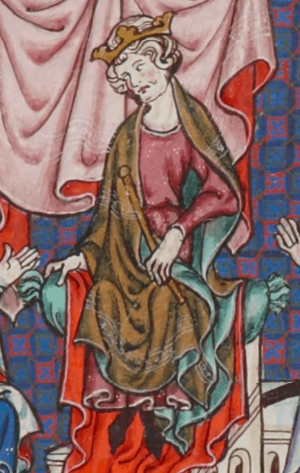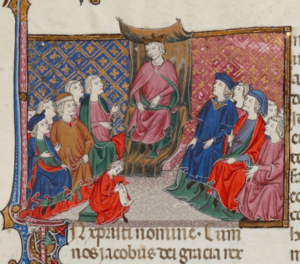James II of Aragon facts for kids
Quick facts for kids James II |
|
|---|---|

James, from a manuscript (BNF, Latin 4670 A) of the Catalan constitutions
|
|
| King of Sicily | |
| Reign | 2 November 1285 – 20 June 1295 |
| Predecessor | Constance II of Sicily and Peter III of Aragon |
| Successor | Frederick III |
| King of Aragon and Valencia Count of Barcelona |
|
| Reign | 18 June 1291 – 2 or 5 November 1327 |
| Predecessor | Alfonso III |
| Successor | Alfonso IV |
| King of Sardinia and Corsica | |
| Reign | 4 April 1297 – 2 or 5 November 1327 |
| Successor | Alfonso IV |
| Born | 10 April 1267 Valencia |
| Died | 2/5 November 1327 (aged 60) Barcelona |
| Burial | Santes Creus |
| Spouse | Isabella of Castile Blanche of Anjou Marie of Lusignan Elisenda of Montcada |
| Issue among others... |
James Alfonso IV of Aragon Maria, Lady of Cameros John Isabella, Queen of Germany Peter IV, Count of Ribagorza |
| House | House of Barcelona |
| Father | Peter III of Aragon |
| Mother | Constance of Sicily |
| Religion | Roman Catholicism |
James II (born 10 April 1267 – died 2 or 5 November 1327), also known as James the Just, was an important king in the history of Aragon. He ruled as King of Aragon and Valencia, and Count of Barcelona from 1291 to 1327.
Before that, he was King of Sicily (as James I) from 1285 to 1295. He was also the King of Majorca for a short time, from 1291 to 1298. Later, from 1297, he was given the title of King of Sardinia and Corsica. However, he only truly gained control of Sardinia in 1324 after a conquest.
James was born in Valencia. He was the second son of Peter III of Aragon and Constance of Sicily. He became King of Sicily when his father died in 1285. Later, in 1291, he became King of Aragon and other Spanish lands, including Majorca, after his older brother Alfonso III passed away.
In 1295, he had to give up Sicily to the Pope. But his younger brother, Frederick III, took control of Sicily in 1296. In 1298, James returned Majorca to its previous king, James II of Majorca. This happened after Pope Boniface VIII gave James II rights to Sardinia and Corsica.
Contents
King James II
Early Rule in Sicily and Aragon
James became King of Sicily in 1285 after his father's death. When his brother Alfonso III died in 1291, James also became the ruler of the Crown of Aragon. This meant he now controlled many important territories.
In 1296, James made a peace treaty with Charles II of Anjou. As part of this treaty, he agreed to give up Sicily. However, the people of Sicily did not want this. Instead, they chose his brother Frederick to be their king.
Gaining Sardinia and Corsica
Because Frederick would not leave Sicily, Pope Boniface VIII asked James II and Charles II of Naples to remove him. To encourage James, the Pope gave him the title to Sardinia and Corsica. The Pope also made him a special officer of the Church, called a papal gonfalonier.
James was not very interested in fighting his brother over Sicily. So, he returned to Aragon. Frederick continued to rule Sicily until he died in 1337.
Agreements with Majorca
In 1295, through the Treaty of Anagni, James returned the Balearic Islands to his uncle, James II of Majorca. However, Aragon kept control over other parts of the Majorca kingdom, like Montpellier and Roussillon, during James's reign.
Later, in 1298, the Treaty of Argilers was signed. In this treaty, James of Majorca officially recognized that James of Aragon was his superior ruler.
Expanding Influence and New Territories
After returning to Aragon, James II wanted to expand his kingdom southwards into Muslim lands. The kingdom of Castile was blocking Aragon's access to these areas. To achieve his goal, James II made an alliance with enemies of the young king of Castile, Ferdinand IV.
James II especially wanted the kingdom of Murcia to gain access to Granada. In 1296, the allied forces attacked from all sides. James II successfully captured Murcia and held it until 1304.
In 1313, James II gave the Aran Valley more control over its own government. The details of this agreement are written in a Latin document called the Querimonia. This power was given to the Aranese people because they promised to support James II in a disagreement with France and Majorca over who controlled the valley.
His Writings
It is believed that James wrote a poem during his time as King of Sicily (1285–1291). This was his only known poem written in the Occitan language. It was a religious song dedicated to the Virgin Mary. A writer named Arnau de Vilanova even wrote a detailed explanation of the poem in 1305.
In his poem, James compared the Church to a ship caught in a storm. He suggested that the ship's pilot (meaning the Pope) was not guiding it well. The poem also asked Mary to protect him, the king, from sin.
Family Life
Marriages and Children
King James II was married four times during his life.
His first marriage was to Isabella of Castile. They married in Soria on 1 December 1291. Isabella was only 8 years old at the time. This marriage was never fully completed and was later cancelled in 1295 after Isabella's father died.
His second marriage was to Blanche of Anjou. She was the daughter of Charles II of Naples, who was a rival of James's family. They married in Villabertran on 29 October or 1 November 1295. Blanche and James had several children together:
- James (born 1296 – died 1334). He gave up his right to the throne in 1319 to become a monk.
- Alfonso IV of Aragon (1299 – 1336). He became King of Aragon in 1327 after his father's death.
- Maria (born 1299 – died 1347). She became a nun.
- Constance (born 1300 – died 1327).
- John (born 1304 – died 1334). He became an Archbishop and Patriarch.
- Isabella of Aragon (born 1305 – died 1330). She married Frederick I of Austria.
- Peter (born 1305 – died 1381). He was a Count.
- Blanche (born 1307 – died 1348). She was a Prioress.
- Ramon Berenguer (born 1308 – died 1366). He was a Count and a priest.
- Violante (born 1310 – died 1353).
His third marriage was to Marie of Lusignan (1273 – 1319). She was the daughter of King Hugh III of Cyprus. They married in 1315. They did not have any children.
His fourth marriage was to Elisenda de Montcada. They married in Tarragona on 25 December 1322. This marriage also did not produce any children. After James's death, Elisenda became a nun.
James also had three children with women from Sicily before his official marriages:
- Sancho (born 1287 in Sicily).
- Napoleón (born 1288 in Sicily).
- James (born 1291 in Mazzara).
Images for kids
-
The tomb statue of James in the royal monastery of Santes Creus.
See also
 In Spanish: Jaime II de Aragón para niños
In Spanish: Jaime II de Aragón para niños





